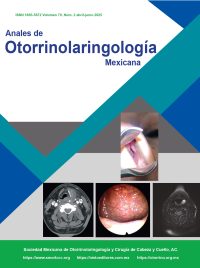An Orl Mex. 2025; 70 (2): 81-89. https://doi.org/10.24245/aorl.v70i2.10247
Karla Escalante Bulbarela,1 Mariana Durán Ortiz,2 Fernando Pineda Cásarez,2 María Teresa Sotelo Ramírez2
1 Otorrinolaringología y Cirugía de Cabeza y Cuello. Facultad Mexicana de Medicina, Universidad La Salle México.
2 Otorrinolaringología y Cirugía de Cabeza y Cuello.
Hospital Regional General Ignacio Zaragoza, ISSSTE, Ciudad de México.
Resumen
OBJETIVO: Evaluar la efectividad estética y funcional de la colagenasa intralesional en cicatrices hipertróficas nasales.
MATERIALES Y MÉTODOS: Estudio cuasiexperimental en el que se incluyeron pacientes con cicatrices hipertróficas posrinoseptoplastia, clasificadas según su antigüedad: 0-6, 7-12 y más de 12 meses. Se aplicó colagenasa intralesional mediante técnica blanching, y los cambios en pigmentación, vascularidad y grosor se evaluaron pre y postratamiento mediante la escala Vancouver, así como en obstrucción nasal mediante la escala NOSE.
RESULTADOS: Se incluyeron 13 pacientes. Las cicatrices recientes (0-6 meses) mostraron mayor reducción en pigmentación (7.7%) y grosor (8.2%). Las cicatrices de mediana antigüedad (7-12 meses) mostraron la mayor disminución en vascularidad (17.8%) y mejoría en el puntaje NOSE (10.8%). Las cicatrices más antiguas (más de 12 meses) tuvieron menor respuesta, con reducciones en pigmentación (5%) y grosor (5.2%).
CONCLUSIONES: La colagenasa intralesional es eficaz en la mejoría estética y funcional de cicatrices recientes y de mediana antigüedad, con menor repercusión en cicatrices más antiguas. Este tratamiento ofrece una alternativa no quirúrgica viable para pacientes con síntomas obstructivos posrinoseptoplastia.
PALABRAS CLAVE: Colagenasa; cicatrización hipertrófica; rinoseptoplastia; obstrucción nasal.
Abstract
OBJECTIVE: To evaluate the effectiveness of intralesional collagenase in improving hypertrophic nasal scars, focusing on aesthetics and functionality.
MATERIALS AND METHODS: Quasi-experimental intersubject pre-posttest design including patients with hypertrophic scars post-rhinoseptoplasty that were classified by scar age: 0-6 months, 7-12 months, and over 12 months. Intralesional collagenase was applied using the blanching technique. Changes in pigmentation, vascularity, and thickness were evaluated using the Vancouver scale, and nasal obstruction was assessed using the NOSE scale, both pre- and post-treatment.
RESULTS: Thirteen patients were included. Recent scars (0-6 months) showed the greatest reductions in pigmentation (7.7%) and thickness (8.2%). Medium-aged scars (7-12 months) had the largest decreases in vascularity (17.8%) and NOSE score improvement (10.8%). Older scars (over 12 months) demonstrated less response, with reductions in pigmentation (5%) and thickness (5.2%).
CONCLUSIONS: Intralesional collagenase effectively improves aesthetics and functionality in recent and medium-aged scars, with a reduced impact on older scars. This treatment offers a viable non-surgical alternative for post-rhinoseptoplasty complications.
KEYWORDS: Collagenase; Hypertrophic scars; Rhinoseptoplasty; Nasal obstruction.
Recibido: 12 de diciembre 2024
Aceptado: 4 de marzo 2025
Este artículo debe citarse como: Escalante-Bulbarela K, Durán-Ortiz M, Pineda-Cásarez F, Sotelo-Ramírez MT. Aplicación de colagenasa en pacientes con cicatrización hipertrófica posterior a rinoseptoplastia. An Orl Mex 2025; 70 (2): 81-89.


